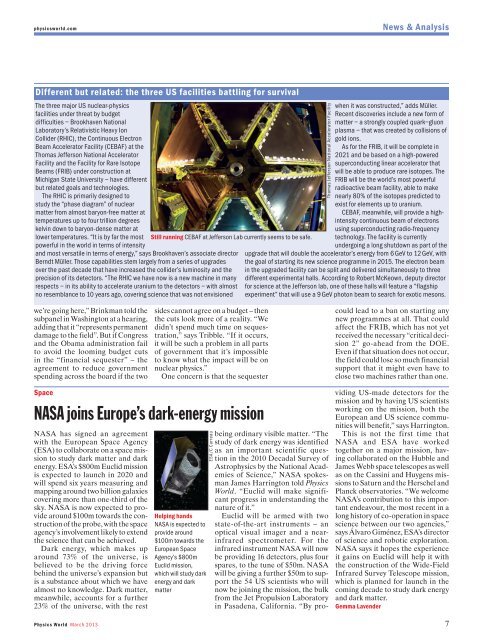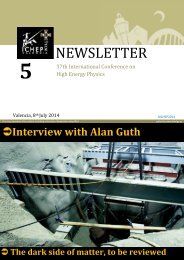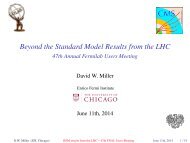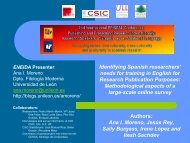PW_mar13_sample_issue
PW_mar13_sample_issue
PW_mar13_sample_issue
You also want an ePaper? Increase the reach of your titles
YUMPU automatically turns print PDFs into web optimized ePapers that Google loves.
physicsworld.com<br />
Different but related: the three US facilities battling for survival<br />
The three major US nuclear-physics<br />
facilities under threat by budget<br />
difficulties – Brookhaven National<br />
Laboratory’s Relativistic Heavy Ion<br />
Collider (RHIC), the Continuous Electron<br />
Beam Accelerator Facility (CEBAF) at the<br />
Thomas Jefferson National Accelerator<br />
Facility and the Facility for Rare Isotope<br />
Beams (FRIB) under construction at<br />
Michigan State University – have different<br />
but related goals and technologies.<br />
The RHIC is primarily designed to<br />
study the “phase diagram” of nuclear<br />
matter from almost baryon-free matter at<br />
temperatures up to four trillion degrees<br />
kelvin down to baryon-dense matter at<br />
lower temperatures. “It is by far the most<br />
powerful in the world in terms of intensity<br />
and most versatile in terms of energy,” says Brookhaven’s associate director<br />
Berndt Müller. Those capabilities stem largely from a series of upgrades<br />
over the past decade that have increased the collider’s luminosity and the<br />
precision of its detectors. “The RHIC we have now is a new machine in many<br />
respects – in its ability to accelerate uranium to the detectors – with almost<br />
no resemblance to 10 years ago, covering science that was not envisioned<br />
we’re going here,” Brinkman told the<br />
subpanel in Washington at a hearing,<br />
adding that it “represents permanent<br />
damage to the field”. But if Congress<br />
and the Obama administration fail<br />
to avoid the looming budget cuts<br />
in the “financial sequester” – the<br />
agreement to reduce government<br />
spending across the board if the two<br />
Space<br />
NASA has signed an agreement<br />
with the European Space Agency<br />
(ESA) to collaborate on a space mission<br />
to study dark matter and dark<br />
energy. ESA’s $800m Euclid mission<br />
is expected to launch in 2020 and<br />
will spend six years measuring and<br />
mapping around two billion galaxies<br />
covering more than one-third of the<br />
sky. NASA is now expected to provide<br />
around $100m towards the construction<br />
of the probe, with the space<br />
agency’s involvement likely to extend<br />
the science that can be achieved.<br />
Dark energy, which makes up<br />
around 73% of the universe, is<br />
believed to be the driving force<br />
behind the universe’s expansion but<br />
is a substance about which we have<br />
almost no knowledge. Dark matter,<br />
meanwhile, accounts for a further<br />
23% of the universe, with the rest<br />
Still running CEBAF at Jefferson Lab currently seems to be safe.<br />
sides cannot agree on a budget – then<br />
the cuts look more of a reality. “We<br />
didn’t spend much time on sequestration,”<br />
says Tribble. “If it occurs,<br />
it will be such a problem in all parts<br />
of government that it’s impossible<br />
to know what the impact will be on<br />
nuclear physics.”<br />
One concern is that the sequester<br />
NASA joins Europe’s dark-energy mission<br />
Helping hands<br />
NASA is expected to<br />
provide around<br />
$100m towards the<br />
European Space<br />
Agency’s $800m<br />
Euclid mission,<br />
which will study dark<br />
energy and dark<br />
matter<br />
ESA/C Carreau<br />
being ordinary visible matter. “The<br />
study of dark energy was identified<br />
as an important scientific ques-<br />
tion in the 2010 Decadal Survey of<br />
Astrophysics by the National Academies<br />
of Science,” NASA spokesman<br />
James Harrington told Physics<br />
World. “Euclid will make significant<br />
progress in understanding the<br />
nature of it.”<br />
Euclid will be armed with two<br />
state-of-the-art instruments – an<br />
optical visual imager and a nearinfrared<br />
spectrometer. For the<br />
infrared instrument NASA will now<br />
be providing 16 detectors, plus four<br />
spares, to the tune of $50m. NASA<br />
will be giving a further $50m to support<br />
the 54 US scientists who will<br />
now be joining the mission, the bulk<br />
from the Jet Propulsion Laboratory<br />
in Pasadena, California. “By pro-<br />
News & Analysis<br />
when it was constructed,” adds Müller.<br />
Recent discoveries include a new form of<br />
matter – a strongly coupled quark–gluon<br />
plasma – that was created by collisions of<br />
gold ions.<br />
As for the FRIB, it will be complete in<br />
2021 and be based on a high-powered<br />
superconducting linear accelerator that<br />
will be able to produce rare isotopes. The<br />
FRIB will be the world’s most powerful<br />
radioactive beam facility, able to make<br />
nearly 80% of the isotopes predicted to<br />
exist for elements up to uranium.<br />
CEBAF, meanwhile, will provide a highintensity<br />
continuous beam of electrons<br />
using superconducting radio-frequency<br />
technology. The facility is currently<br />
undergoing a long shutdown as part of the<br />
upgrade that will double the accelerator’s energy from 6 GeV to 12 GeV, with<br />
the goal of starting its new science programme in 2015. The electron beam<br />
in the upgraded facility can be split and delivered simultaneously to three<br />
different experimental halls. According to Robert McKeown, deputy director<br />
for science at the Jefferson lab, one of these halls will feature a “flagship<br />
experiment” that will use a 9 GeV photon beam to search for exotic mesons.<br />
could lead to a ban on starting any<br />
new programmes at all. That could<br />
affect the FRIB, which has not yet<br />
received the necessary “critical decision<br />
2” go-ahead from the DOE.<br />
Even if that situation does not occur,<br />
the field could lose so much financial<br />
support that it might even have to<br />
close two machines rather than one.<br />
viding US-made detectors for the<br />
mission and by having US scientists<br />
working on the mission, both the<br />
European and US science communities<br />
will benefit,” says Harrington.<br />
This is not the first time that<br />
NASA and ESA have worked<br />
together on a major mission, having<br />
collaborated on the Hubble and<br />
James Webb space telescopes as well<br />
as on the Cassini and Huygens missions<br />
to Saturn and the Herschel and<br />
Planck observatories. “We welcome<br />
NASA’s contribution to this important<br />
endeavour, the most recent in a<br />
long history of co-operation in space<br />
science between our two agencies,”<br />
says Álvaro Giménez, ESA’s director<br />
of science and robotic exploration.<br />
NASA says it hopes the experience<br />
it gains on Euclid will help it with<br />
the construction of the Wide-Field<br />
Infrared Survey Telescope mission,<br />
which is planned for launch in the<br />
coming decade to study dark energy<br />
and dark matter.<br />
Gemma Lavender<br />
Physics World March 2013 7<br />
Thomas Jefferson National Accelerator Facility








